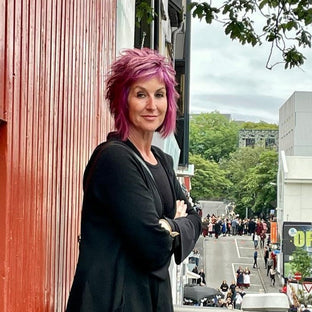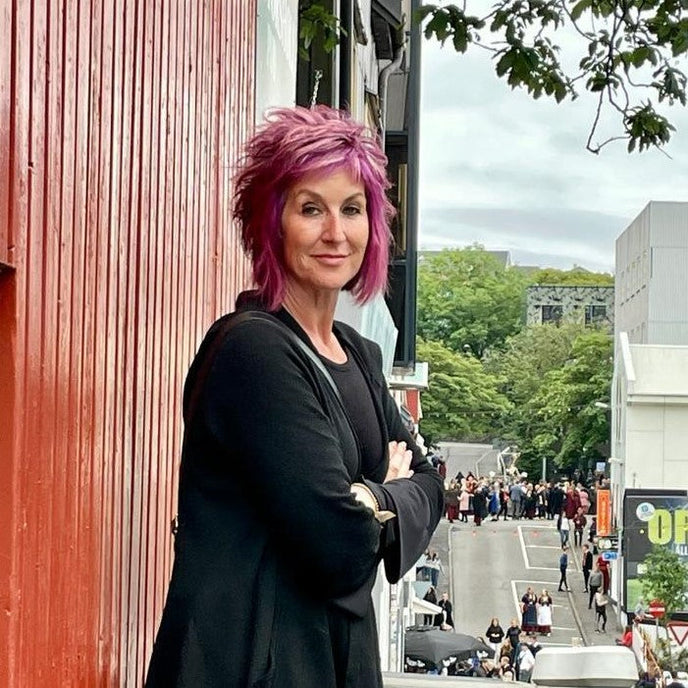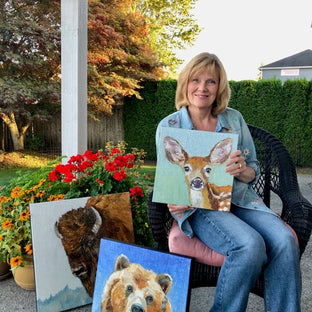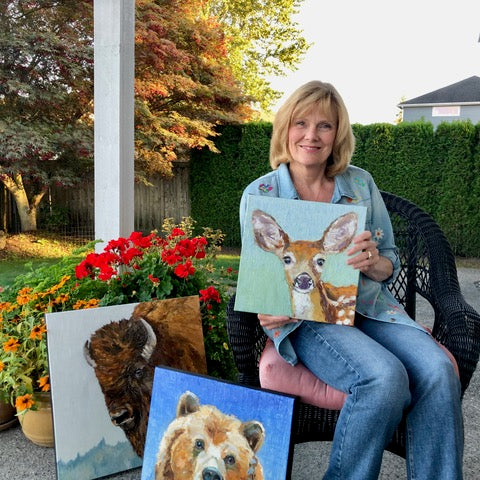A Creative Interview With Artist John Jaster
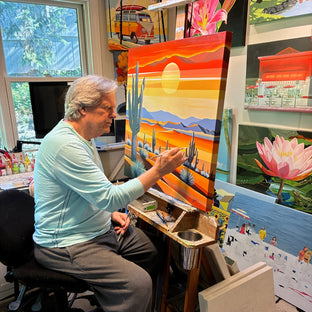
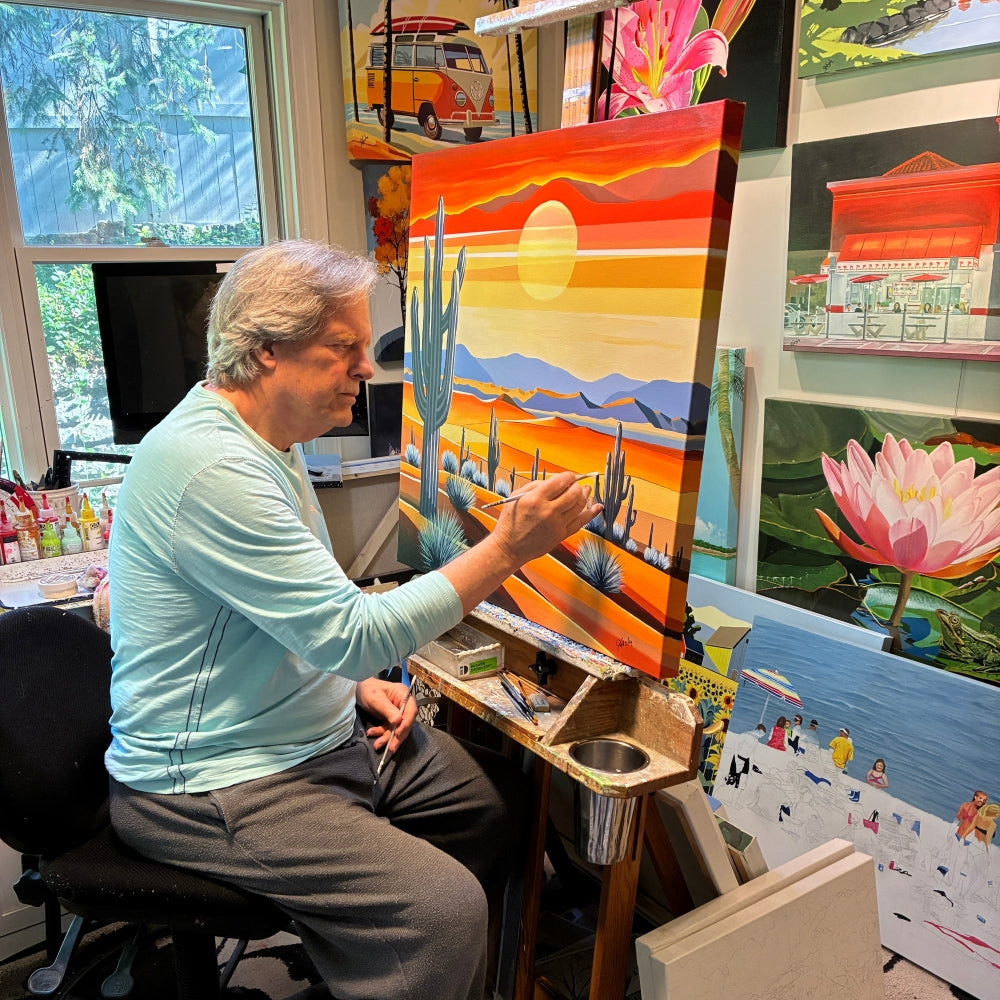

"I try to create realistic impressions that will rekindle the sense of wonder we all had as children when we began to discover the beauty in nature."
Artist John Jaster colorfully depicts his adventures across the United States in a style he describes as realistic impressions. In college, John felt a pull towards computer science and pursued a career in software architecture. Although the two paths may seem unrelated, John says his work in software strongly influences his artwork in distilling complex systems without losing the magic and wonder. John paints from a home studio with a fireplace, abundant natural light, and jazz playing in the background.
In this interview, John shares his process and the questions he asks himself to make good art.
What's your home life like?
I live with my wife of 40 years and our Cavachon puppy in Dayton, Ohio. The area we live in is covered with pine, birch, and maple trees, with a stream running through it and a deer trail alongside. My studio has floor-to-ceiling windows that look out at the abundance of nature, which certainly influences my leaning toward landscapes and flowers.
What are you most proud of—whether in art or another part of your life?
Well, my lifetime marriage to the woman I dated in college ranks number one. I am also very proud that after dabbling in art in my youth, I came back to it 40 years later with a determination to see if I could develop my talent to paint professionally. One of the greatest pleasures in my life is to send off one of my paintings to someone who thinks enough of my art to purchase it.
Do you have any studio rituals that help you get into a creative flow?
After a career in computer science, I am very disciplined about creating a workflow and sticking to it. By this, I mean that after spending hours researching photos, modifying them on the computer, combining, recoloring, sketching, and then griding them onto a canvas, I work out a plan on how to implement the painting. For instance, what colors should I start with, and what areas do I want to work on first, second, and last? Who are the main actors that I have to get right, or everything else fails? What are the most difficult problems I will need to solve? What sections should have the impact of realism, and what needs to be more impressionistic? What colors do I want to enhance, fade, or change?
Although each painting is different, the workflow process is the same. I study the image on the computer and mentally map it to the grid, choosing the plan that will keep me focused and interested enough to complete the painting. Sometimes, I make pencil notes on the canvas. The larger the painting, the longer it takes and the harder it is to keep that focus. One of the tricks I use is to complete one or more of the focal points early to give myself that 'wow' factor, which keeps me in the game until the end.

How do you structure your day?
I try to get my coffee, news, and workout done before I sit in front of my easel at nine in the morning. The first thing I do is review what I've accomplished so far to make any corrections or enhancements before I start the next step. Since I work in acrylics, which generally need multiple layers of paint to get the right color value, I almost always add layers of paint to sections that look dull or not exactly correct. Then, I work on the next steps until two in the afternoon. I clean my brushes, and I'm done until tomorrow.
Where do you find inspiration for your art?
Most of my inspiration comes from voraciously searching for and studying other artist's work. I like to get that 'boy, I wish I had painted that' feeling when I look at a painting. When I get it, I study that particular painting, trying to figure out how the artist accomplished it. What makes it unique? Why am I attracted to it? How would I apply my style to the same scene or subject? What would I change?
I have always thought of myself as a student painter. I learn from every work of art I study. I try out techniques. Some I incorporate into my bag of skills. I grow. I change. I fear stagnation. After all, Picasso went through at least eight stages in his career.
Tell us about your evolution as an artist.
As a boy, I could draw anything just by looking at it. I drew faces, hands, cars, you name it. During college, I took up acrylics and painted large works of album covers, giving them away, never taking my skill seriously. After a degree in computer science, my career took me away from painting. Then, in 2010, my wife bought me a large easel and encouraged me to start painting again. I began to take art seriously. Nearly 300 gallery shows and juried contests later, I am still learning and enjoying life as a painter.
How do you decide when an artwork is finished?
Since I review the progress of my painting as the first task in my daily work schedule, I am also evaluating how close I am to the original plan. When the canvas is covered and the colors are what I hoped for, the painting is finished. But maybe not complete.
I have a 4–5 days review period where I hang the painting on my gallery wall right behind and to the right of my easel. I look at it a dozen times a day while I prepare the next canvas and work plan. I make a point to view it from different angles and distances. I pretend I am walking into a new gallery and gaze across the artwork on the wall. Does this painting catch my eye? Does it stand out? Once I focus on it, do I get that 'wow' feeling? Or do I sense that something is off, not what I hoped? During this period, I will often put it back on the easel to make corrections or changes.
Occasionally, I may make some substantial changes, like painting over some object or area. A few times a year, I will declare it unsalvageable.
What is the most interesting observation someone has made about your work?
I completed a large commission once on a farm landscape. The owners sent me a picture of the painting hanging in their house with a letter telling me how they like to stand in front of it each evening and reminisce about their own lives growing up on a farm, often with tears and joy. This is the hope I have for all my paintings.
Is there an artwork from another artist that has had a significant impact on you?
Early on in my career, I would point to Edward Hopper. I was amazed at the stark simplicity of his work. The valuable lesson I learned was that I didn't need to try and paint everything visible in a reference photo or scene. My goal as an artist is to tell a story about a moment in time. An impression that makes an impact on the observer. Too much information distracts.
What's your favorite museum?
I've been to the Louvre, so obviously, it made an impact. But the Columbus Museum of Art is where I go to study art. It has some incredible exhibitions of the greatest painters in history. Probably the most impactful was a retrospective of the great Dutch painters. A good student can find a hundred lessons on each visit.

Is there anything else you'd like to share to help viewers better understand your work?
I try to create realistic impressions that will rekindle the sense of wonder we all had as children when we began to discover the beauty in nature. I use color to catch the attention of the viewer. And I surround areas of realism with impressionistic patches to enhance the contrast.


